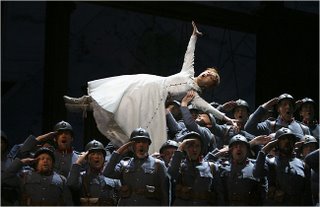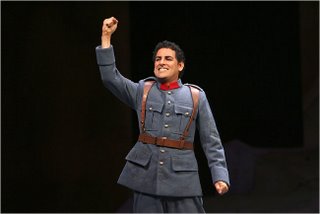The “Enchanting” Santa Fe Opera Festival
Daniel Turp*
Special collaboration
After putting it off for several years, attending Santa Fe Opera this summer was a great decision. The French soprano Natalie Dessay, sharing the stage with her husband, baritone Laurent Naouri, sang her first Violetta in a new production of La Traviata, directed by Laurent Pelly. The 2009 season also included Donizetti’s L’Elisir d’Amore, Mozart’s Don Giovanni, Gluck’s Alceste and the creation of American composer Paul Moravec’s The Letter, commissioned by the Santa Fe Opera.
This year was also Charles MacKay’s first season as general and artistic director. At an event organized jointly between the Center of Contemporary Arts Cinematheque and the Santa Fe Opera at Santa Fe’s Lensic Theatre, MacKay recalled the dynamic role the Santa Fe Opera has played in the community. Before the screening of the Met HD’s production of La Fille du Régiment, MacKay’s fascinating exchange with Natalie Dessay allowed the soprano to reveal herself as, in his words, a “singing actor.”
During my interview with MacKay on the impressive grounds of the Santa Fe Opera, seven miles north of Santa Fe, he appeared both determined and optimistic. Sante Fe Opera is perhaps perceived more as a festival, he acknowledged, because its productions are all held in the summer, yet, with its apprentice programs for both singers and technicians, its year-round cooperation with musical organisations such as the Santa Fe Chamber Music Festival and its commitment to the community, the Santa Fe Opera is really a true opera company. It has a “collective consciousness” due to its founding director John Crosby and his successor Richard Gaddes, who, for more than half a century, brought together creative individuals, thus contributing to the emergence of a community of professional musicians. Having been part of this community and held many positions at the Santa Fe Opera, including that of business manager, Charles MacKay is keen on nurturing this consciousness. The experience he gained as general director of the Spoleto Festivals in the United States and Italy and in the Opera Theatre of Saint Louis should serve him well.
Asked to describe the Sante Fe Opera in one word, Charles MacKay promptly answered “enchanting,” perhaps in reference to New Mexico’s state motto “Land of Enchantment.” MacKay argues that it has more to do with the natural setting where the operas are sung: the sky, the clouds, the sunsets that are part of each opera and that many stage directors have brilliantly integrated into their “mise en scène.”
Three evenings at the John Crosby Theatre proved to be enchanting. Laurent Pelly gave an audacious rendering of La Traviata, Verdi’s most popular work. L’Elisir d’Amore with the American tenor Dimitri Pittas as a delightful Nemorino was amusing, as Donizetti’s cherished piece should be. Enchanting does not mean perfect, however, not even at Santa Fe! Making Mozart’s Don Giovanni credible is a challenge and this production did not quite succeed. The staging was conventional and the characters were seldom “in character.” Although I didn’t get to see it, The Letter, composed by Paul Moravec, received mixed reviews.
Mixed reviews of contemporary commissioned operas will not, however, deter the company from its commitment to creating new works. The Letter was the ninth such opera since the SFO’s birth in 1957 – an average of one new opera every six years. And since Charles MacKay believes that opera is a “compelling form” of musical expression, his plan for the company includes new commissions for 2013 and 2015. The Santa Fe Opera will take up the challenge of trying to attract the best conductors, stage directors and singers worldwide. Santa Fe was the home of Igor Stravinsky, and it is where the careers of such great singers as Chris Merrill and Joyce DiDonato began. Tatiana Troyanos, Ben Heppner, Bryn Terfel and Natalie Dessay have all brought fame to Santa Fe!
One of the most important decisions Charles MacKay faces is the appointment of a new music director, or more probably, as MacKay noted, a chief conductor. The Santa Fe Opera will be looking for stability in this key position. It has known only one music director, Alan Gilbert (2003-2006), who was replaced – on an interim basis and for the 2007 season only – by Kenneth Montgomery. Appointed as chief conductor in 2007, Edo de Waart will be leaving at the end of this season. The shortlist features strong candidates according to Charles MacKay, but this key decision will not be rushed.
I could not resist mentioning Yannick Nézet-Séguin, conductor of Montreal’s Orchestre Métropolitain. His credentials as an opera conductor have been enhanced after his stellar direction of Gounod’s Roméo et Juliette at the 2008 Salzburg Festival and his hiring by the Metropolitan Opera’s director Peter Gelb to conduct the new production of Bizet’s Carmen next season. Charles MacKay calmly opened his notebook and asked me how to spell his name! He remarked that Bernard Labadie had conducted Mozart’s Lucio Silla expertly in Santa Fe in 2005. I recalled on my part that Quebec bass Claude Corbeil had taken part in at least twelve productions of the SFO.
*****
Santa Fe is enchanting not only because of opera. Its art galleries along the elegant Canyon Road as well as its museums provide hours of cultural enlightenment, including a better knowledge of the contribution of the native peoples to the cultural heritage of humankind. In Santa Fe, visitors can be inspired, not only by works of art, but also by the words of artists, such as those of the great painter Georgia O’Keefe who considers that “[s]inging has always seemed to me the most perfect means of expression.”
* President of la Société des arts en milieux de santé and a candidate for the Certificat Musique, art et société at the Faculté de musique de l’Université de Montréal. The interview with Charles MacKay was held on Tuesday, July 14, 2009, and the author wishes to thank Ms Joyce Idema, the director of communications at the Santa Fe Opera, for having made this interview possible. To learn more about the Santa Fe Opera, I recommend reading the beautiful 50th SFO anniversary album authored by Philip HUSCHER, The Santa Fe Opera – An American Pioneer, Santa Fe, The Santa Fe Opera, 2006, 199 p.
Labels: Festivals, Natalie Dessay, Santa Fe





